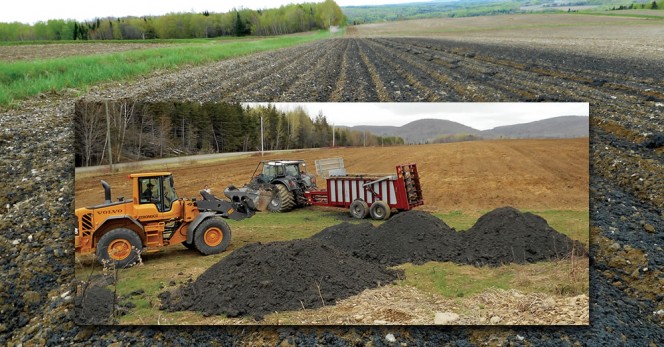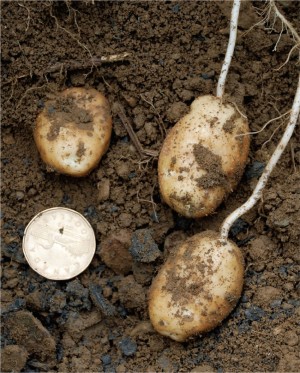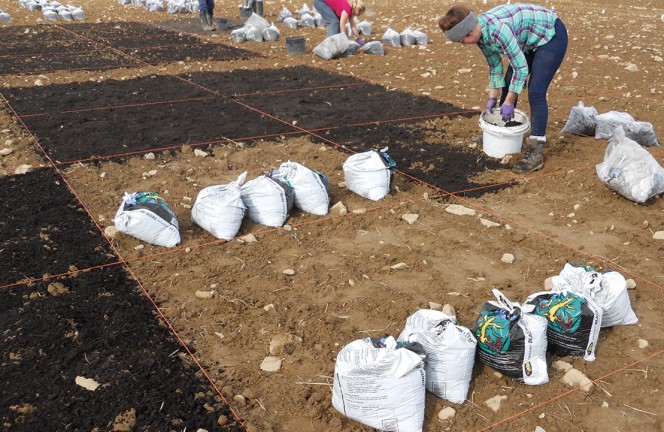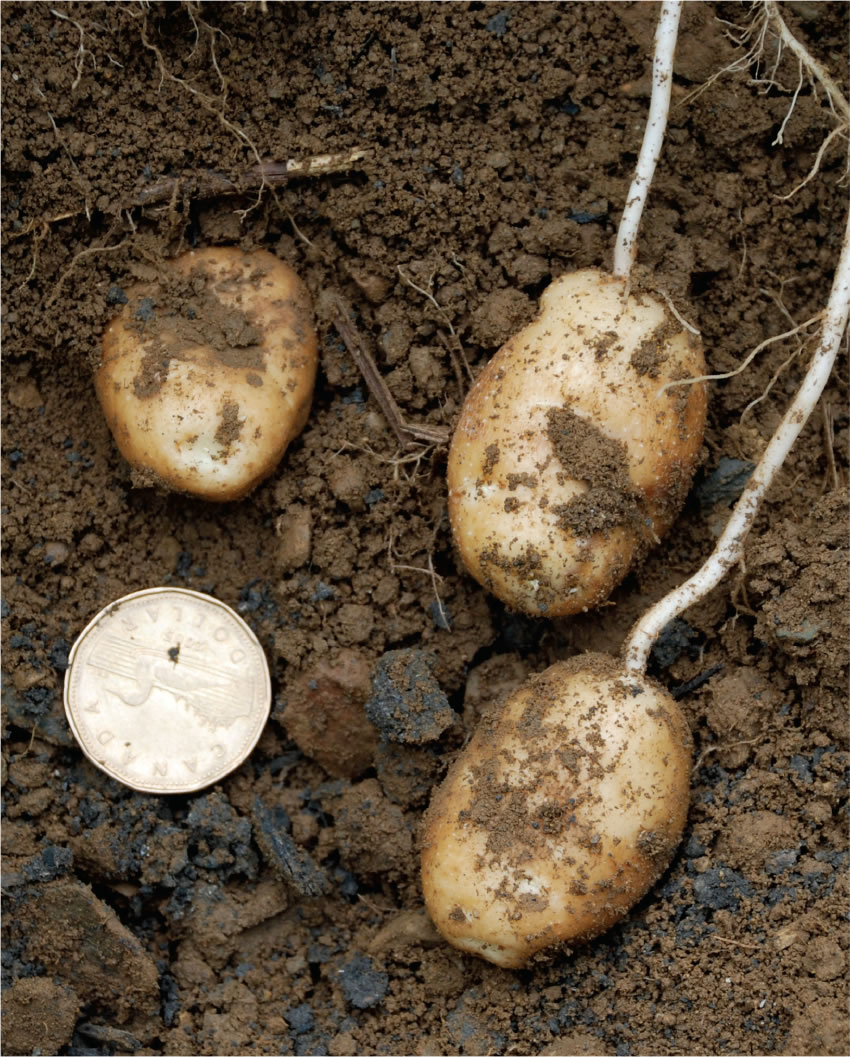Growers in New Brunswick, Canada, where the potato industry is struggling, have “an organic matter crisis.” Compost use trials have been underway for several years.
Peter Gorrie
BioCycle December 2015

McCain Foods, which processes about 60 percent of New Brunswick’s potato crop into frozen French fries, has been participating in commercial-scale compost trials. The compost, produced by Envirem, has been applied at a rate of 27.5 tons/acre. Photos courtesy of McCain Foods (Canada)
Research is being conducted in New Brunswick, Canada to determine whether applying compost on farmland is an affordable way to strengthen the province’s struggling potato industry — a mainstay of the economy for more than a century. Although the New Brunswick Potato Board says the East Coast province has “the perfect climate and topography” for growing the tubers, acreage is declining and yields are stagnant while production elsewhere in North America expands.
Competition comes from areas such as Idaho, Washington State and Wisconsin, where growers operate on much larger, flatter farms and can precisely deliver moisture, fertilizer, fungicides and other inputs through sophisticated irrigation systems. These regions produce up to 600 hundredweight (60,000 pounds) of potatoes per acre — nearly double the yield in New Brunswick and Canada’s other major Atlantic coast producer, Prince Edward Island.

The average yield of potatoes grown in compost-amended soil (above) has increased by 15 to 20 hundred weight per acre. Photos courtesy of McCain Foods (Canada)
The potato industry in New Brunswick must cope with depleted soil, increasingly uncertain weather, a relatively short growing season and the impact of local changes in agriculture: New Brunswick’s potato farms no longer include the livestock operations that provided manure to maintain soil organic matter. Those involved are convinced compost has long-term benefits. They also know the relatively high cost of buying, transporting and spreading it. The tests — being conducted at both commercial field-scale and in small research plots — aim to determine whether, and how, compost could provide enough of a yield increase and other financial benefits to offset those costs.
Improved seed quality, crop rotations and use of technology such as GPS and yield monitors are other measures being studied, with the goal of increasing the average annual potato yield by 45 hundredweight per acre over four years. That improvement, combined with the province’s proximity to the large American eastern seaboard market, could help to ensure a healthy industry.
The competitive challenge is clear, says Joe Brennan, project leader with Potatoes New Brunswick, the industry advocacy group: “In the western regions the sun is a given. They know they won’t get enough rain, so irrigation is needed every year. It’s like an outdoor greenhouse. There’s enough sun and they control moisture and nutrients. Here, there’s little irrigation and we depend on rainfall. With rainfall, you sometimes see a deficit of water, or it doesn’t always come when you need it, and you can’t turn it off. Good healthy soil with good organic matter can absorb and retain moisture. It’s not perfect, but with more organic matter it will do a much better job. Organic matter is our major way to manage water.”
But that crucial soil ingredient has been declining, Brennan adds. “We know we have an organic matter crisis. The land has been farmed hard. Organic matter numbers are not where they should be.”
Potatoes “work the land pretty hard,” says Roger Henry, a composting technician with Agriculture and Agri-Food Canada, the federal department based on Prince Edward Island. Potatoes draw in a lot of nutrients. They’re grown on a short rotation with other crops, leaving little opportunity for the soil to be replenished. And they take a long time to grow, which means they’re harvested in late fall when fields are typically wet. That situation leads to soil compaction, which destroys its structure and, in turn, increases water and wind erosion.
Commercial-Scale Trials
The field-scale tests are funded in part by McCain Foods, the New Brunswick-based international giant that processes about 60 percent of the province’s potato crop into frozen French fries. McCain is testing compost produced by Envirem Organics that is made out of manure from nearby poultry producers, and sawdust, wood chips and bark from the province’s forest industry.
Compost applications, at a rate of 27.5 tons per acre for three consecutive years, began in the fall of 2013. To date a total of 300 acres on 10 sites has received at least one treatment. “The average yield has increased by 15 to 20 hundredweight per acre, with considerable variation from field to field and between the initial two years of testing, depending on soil conditions, weather and other factors,” says Gilles Moreau, who heads the research into soil and water issues for the New Brunswick Potato Industry Transformation Initiative.
The application rate amounts to a “shock treatment,” Moreau adds. So far, the best results have come from loamy soils with higher organic matter, rather than from sandy or gravel soils with low organic content. “Some of those poor areas would probably need a lot more compost to make a difference,” he says. “The early yield gains aren’t high enough to compensate for the cost of buying, transporting and spreading the compost.”
The trials will show whether results improve with two or three years of compost, but, in any case, “as an industry we have to look at it in a different way,” Moreau notes. “We can’t expect the cost of an amendment will pay for itself the year of application. We need a change of mindset.”
He adds that “compost should be viewed in the same way as lime, which is applied to regulate a soil’s pH level.” Years of production data show potatoes thrive at a pH of around six. Growers know that when pH drops to 5.6 or 5.7 it’s time to add enough lime to get a little above the optimum level. These treatments are expensive, but last three or four years and are budgeted for over that period. “There’s no similar data for organic matter,” Moreau explains. “That is a serious lack of knowledge.” Growers need to know the original organic matter, what level is required for the best yield, and at what point more should be applied, and in what quantities, for optimum results.
Such knowledge might let growers apply compost only when and in the amount needed, with a substantial cost reduction. The benefit could be increased by adjusting crop rotations and other farm practices to improve the soil’s health.
Moreau hopes for an extension to his four years of funding, since compost impacts are long-term. “You don’t change soil very rapidly,” he says. “It’s a very complex physical, chemical and biological system. Things don’t happen quickly, especially when you’re working with organic matter.”
Research Plots
Meanwhile, scientists from Agriculture and Agri-Food Canada, as well as Dalhousie University, in Halifax, Nova Scotia, are conducting the small plot-scale tests, assessing the impacts of composts from a variety of feedstocks, including: Forestry residues including bark, paper mill residue and wood ash, with about 5 percent manure; Poultry manure, with paper mill residue and wood ash; Hen and sheep manure, with bark; Municipal source separated organics; and Marine shells, with bark, farm waste, manure, perlite, peat and lime.

Plot-scale tests are assessing impacts of compost from various sources (in bags) on potato productivity, availability of nutrients, soil quality and ability to suppress soil-borne diseases. Photo courtesy Bernie Zebarth, Agriculture and Agri-Food Canada
These trials are intended to measure the effect of each type of compost on potato productivity, availability of nutrients, impact on soil quality and the ability to suppress soil-borne diseases — a key issue for potato producers.
While it’s too soon to report data, “we’re seeing some beneficial results, depending on the compost feedstock,” says Bernie Zebarth, a soil scientist at the department’s Fredericton Research and Development Centre, in the provincial capital. “It’s pretty early on, we’re reluctant to say, but it looks promising.”
Compost is being studied for its potential to improve soil health and structure, Zebarth adds: “We’re not applying it for nutrients. We’re after it as a way to increase soil organic matter.” In fact, they are focusing on mature, stable compost to avoid a flush of nitrogen and other nutrients when it’s first applied.
The researchers expect the most important benefit of the additional organic matter will be to aid the soil’s ability to hold moisture. That would not only reduce stress on the potato crop in dry periods but also, by reducing run-off and leaching in heavy rains, give growers better control over the nutrients they provide through commercial fertilizers. It’s also “food for good bugs, which keep bad bugs in check,” notes Henry of Agriculture and Agri-Food Canada.
Peter Gorrie is a Contributing Editor to BioCycle. Research for this story is part of a multiyear agricultural research and market development initiative by The Compost Council of Canada, Region of Peel (Ontario), compost producers, farmers and government agencies.













